#ceratophryidae
Explore tagged Tumblr posts
Text

Amazonian Horned Frog (Ceratophrys cornuta), family Ceratophryidae, found in northern South America
photograph by George Grall
732 notes
·
View notes
Text
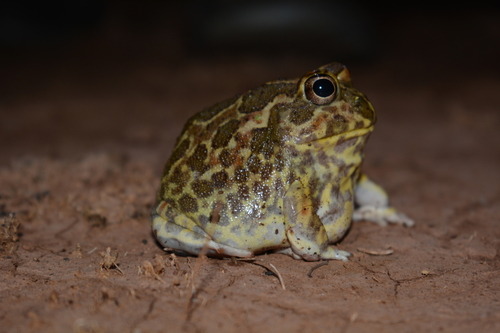
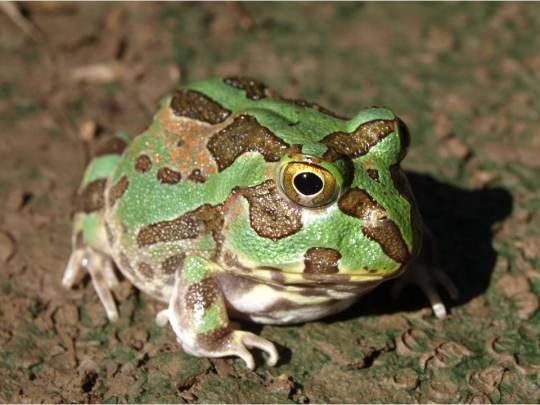
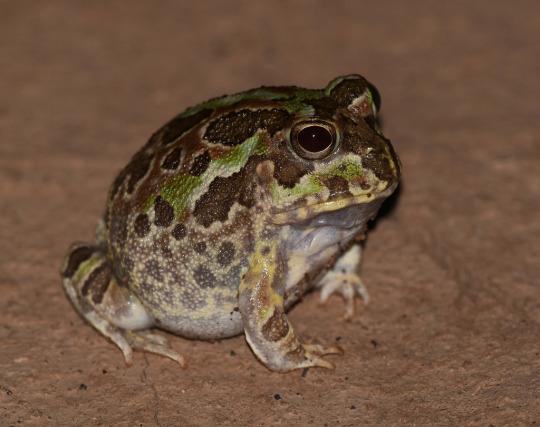
Chatting with the Chaco Horned Frog
The Chacao horned frog, also known as the lesser Chini frog (Chacophrys pierotti) is a species of horned frog found in central South America, from northern Argentina to Paraguay and Bolivia. It resides in an area known as the Gran Chaco or Dry Chaco, named for its high temperatures and lack of rainfall. Within this region, the Chaco horned frog resides mainly in dry scrubland, floodplains, and dry tropical forests.
Due to the extreme environment in which they live, lesser Chini frogs spend most of the year underground. During the cool, dry season from May to September, adults dug burrows and hibernate; to keep themselves moist, they surround themselves in a cocoon of dead skin. Once the rainy season begins in October, they emerge to feed and breed. Like most frogs, the diet of C. pierotti consists mainly of insects; particularly beetles, ants, bees, butterflies, and moths, and occasionally smaller frogs or tadpoles. There is no record of predators targeting this species, though their small size likely makes them an easy target for foxes, coyotes, and opossums.
At only 4.5 - 6.5 cm (1.7 - 2.5 in) long, lesser Chini frogs are on the small side. However, they generally appear rather plump and round-- the better to retain moisture during the dry season. Adults can appear mottled brown or green, which helps them to camouflage against the surrounding foliage. Despite their name, Chaco horned frogs have no horns or similar-looking appendages.
Mating occurs throughout the rainy season, and typically peaks in January. Males attract females by calling, especially just after heavy rains. Females lay their eggs in the rivers and temporary lagoons that form, and the larvae hatch some time later. Tadpoles only take about 2 weeks to metamorphose into adults, and by the following rainy season they are ready to mate. Individuals typically only live to be about 5 years in the wild.
Conservation status: The IUCN has classed C. pierotti as Least Concern. However, it is threatened by habitat loss due to agriculture and deforestation, and by collection for the pet trade.
Photos
Nadia Bach
Norman Scott
Josh Vandermeulen
#chacao horned frog#Anura#Ceratophryidae#common horned frogs#frogs#amphibians#grasslands#grassland amphibians#tropical forests#tropical forest amphibians#south america#central south america
89 notes
·
View notes
Text
Horned Frogs: Masters of Camouflage and Ambush
In the world of amphibians, few creatures capture the imagination quite like the horned frog. Known for their distinctive appearance and unique behaviors, horned frogs, belonging to the Ceratophryidae family, are fascinating inhabitants of various ecosystems. This article will explore the characteristics, habitats, and intriguing features that make horned frogs a captivating subject in the realm of amphibians.

In the world of amphibians, few creatures capture the imagination quite like the horned frog. Known for their distinctive appearance and unique behaviors, horned frogs, belonging to the Ceratophryidae family, are fascinating inhabitants of various ecosystems. This article will explore the characteristics, habitats, and intriguing features that make horned frogs a captivating subject in the realm of amphibians.
I. Introduction to Horned Frogs
Horned frogs, also referred to as pacman frogs due to their resemblance to the iconic video game character, belong to the Ceratophryidae family. These frogs are native to South America and have gained popularity in the exotic pet trade due to their distinctive appearance and intriguing behaviors horned frogs cup.
II. Physical Characteristics: A Cloak of Camouflage
One of the most striking features of horned frogs is their appearance. Their bodies are broad and flat, resembling a leaf or a stone, providing excellent camouflage in their natural habitats. Explore the variations in colors and patterns that different species of horned frogs exhibit, ranging from vibrant greens to earthy browns.
III. Horned Protrusions: Defensive Adaptations
True to their name, horned frogs possess bony, pointed protrusions above their eyes, resembling horns. While these may look intimidating, their primary function is camouflage. However, when threatened, horned frogs can arch their bodies and raise these "horns," adopting a defensive posture to deter potential predators.
IV. Diverse Species: An Array of Horned Frog Varieties
The world of horned frogs is diverse, with several species exhibiting unique characteristics. Explore different species, such as the Argentine horned frog (Ceratophrys ornata), Cranwell's horned frog (Ceratophrys cranwelli), and the Fantasy horned frog (Ceratophrys hylandersi), each with its own set of colors and patterns.
V. Habitats: From Tropical Forests to Grasslands
Horned frogs inhabit a range of ecosystems, from tropical rainforests to grasslands and savannas. We'll delve into the specific environmental conditions preferred by different species, shedding light on how these frogs have adapted to diverse habitats.
VI. Dietary Habits: Ambush Predators of the Amphibian World
Horned frogs are renowned for their ambush predation tactics. Their diet consists mainly of insects, small mammals, and even other frogs. Explore how their patient waiting, aided by their excellent camouflage, allows them to strike swiftly and consume prey nearly their own size.
VII. Reproduction: Unique Breeding Strategies
The breeding habits of horned frogs are equally fascinating. We'll discuss their unique reproductive strategies, including the male's role in guarding the eggs and tadpoles, as well as the intriguing parental care exhibited by some species.
VIII. Life in Captivity: Horned Frogs as Exotic Pets
Due to their unique appearance and relatively straightforward care requirements, horned frogs have become popular choices in the exotic pet trade. Learn about the considerations and responsibilities involved in keeping horned frogs as pets, from creating a suitable habitat to understanding their dietary needs.
IX. Conservation Status: Challenges and Threats
While not all horned frog species are currently classified as endangered, some face threats due to habitat loss and the pet trade. Explore the conservation status of various horned frog species and the efforts being made to preserve their natural habitats.
X. Educational Importance: Studying Horned Frogs in Scientific Research
Beyond their roles in the pet trade, horned frogs contribute to scientific research. We'll highlight how these amphibians are valuable subjects in studies ranging from ecology to physiology, offering insights into broader aspects of amphibian biology.
XI. Cultural Significance: Folklore and Symbolism
In some cultures, horned frogs hold symbolic significance. Discover the folklore and cultural representations associated with these unique amphibians, exploring how they have become characters in stories and legends.
XII. Conclusion: Horned Frogs - Nature's Masters of Stealth
In conclusion, horned frogs stand out as remarkable creatures in the world of amphibians. Their unique appearance, ambush predation tactics, and adaptability to diverse environments make them both captivating subjects for enthusiasts and valuable contributors to scientific understanding.
1 note
·
View note
Text

A particularly large species of prehistoric frog described in 2008. Common names assigned by the popular media include devil frog, devil toad, and the frog from hell. Fossils of Beelzebufo have been recovered from strata of the Maevarano Formation in Madagascar, dating to the late Cretaceous period, its assumed to have lived 66-70 million years ago. It is considered to be closely related to Baurubatrachus from the Late Cretaceous of Brazil, with both possibly being close relatives, though not members of, the extant South American frog family Ceratophryidae.
Carnivore
Art (c) reneg661
1 note
·
View note
Photo

Ceratophrys calcarata by Andrés Acosta
#Anura#Ceratophryidae#Ceratophrys#Ceratophrys calcarata#frog#frogs#animal#animals#biology#nature#wildlife#fauna#amphibian#amphibians#zoology#herpetology#herps#critter#critters
344 notes
·
View notes
Text
frog of the day :)
Ceratophrys ornata, Common names: Argentine pacman frog, ornate horned frog, Argentine wide-mouthed frog

Habitat: Swamps, bogs and other shallow bodies of water. Near grassland areas.
Found in: South America and Africa. Most common in Brazil, Uruguay and Argentina.
Fun fact(s): They are the most common species of pacman frog, a very unique and interesting frog family!
They are large frogs, growing 5 to 7 inches in length, on top of this, pacman frogs are characterized for being very wide as well, making this guy even bigger.
Being pacman frogs, they are carnivorous frogs, who go after some pretty large prey. Pacman frogs are known to eat anything that can fit in their, very large for a frog, mouths. In the wild, an Argentine pacman frog’s diet would consist mainly of mice, small reptiles, spiders and locusts.
Pacman frogs, including the Argentine pacman frog, are popular as pets. The Argentine pacman frog’s diet in the wild is somewhat hard to recreate, but pets are usually fed large locusts and crickets, and sometimes live fish.
Their tadpoles can make distress calls, and they were the first species of frog recorded to be able to do this


#frog of the day#.GENUS: Ceratophrys#Ceratophrys ornata#FAMILY: Ceratophryidae (pacman frogs)#pacman frogs
70 notes
·
View notes
Note
what's your take on pacman/ornate horned frogs?
Okay so Ceratophrys themselves are pretty great (all round frogs are good frogs), but have you heard of PROceratophrys?

[source]
Some species are just like Ceratophrys, but with eighteen times the eyebrow.
Like, honestly?

[source]
Whose idea was this?
Interestingly, even though they're called PROceratophrys, they're not even in the same family (Odontophrynidae versus Ceratophryidae), and are separated by over 60 million years. Proceratophrys are more closely related to bufonid toads and hylid tree frogs than they are to Ceratophryidae!
Sometimes taxonomy is just dumb that way.
#evolution#frogs#taxonomy#animals#horned frogs#Proceratophrys#the best part is that those horns are apparently not bony#which means they're soft tissue#so when you poke them they probably bend#and I can only imagine they then kind of wobble back into position#and now I have a mighty need to go to South America and find some Proceratophrys to poke#this did NOT answer your question#sorry about that#the short answer is that I think they're fascinating but I personally would not want to keep them#answers by mark
256 notes
·
View notes
Photo

The fossil record and phylogeny of South American horned frogs (Anura, Ceratophryidae)
Raúl Orencio Gómez & Guillermo Fidel Turazzini
Abstract
South American horned frogs (Ceratophryidae), with their large heads, wide gapes and fang-like teeth, are among the most charismatic, best-known and well-studied neobatrachian anurans. The family comprises 12 extant species with hyperossified skulls and has a relatively rich fossil record, particularly in the Pampas, which dates back to the late Miocene.
However, several records have been overlooked in recent summaries, and many taxonomic assignments remain indeterminate or are questionable and have yet to be tested within a quantitative phylogenetic framework.
Here we provide a complete up-to-date survey of the palaeontological record of Ceratophryidae, including some remarkable new records. We also tested their systematic position through comprehensive phylogenetic analyses based on osteological data, providing several synapomorphies for all relevant nodes.
Finally, we discuss these integrated data in relation to divergence time estimates, and propose a set of fossil calibrations that provide hard minimum bounds for crown-group Ceratophryidae and the subclades within it, and illuminate the acquisition of polyploidy within the group.
Read the paper:
https://www.tandfonline.com/doi/abs/10.1080/14772019.2021.1892845?journalCode=tjsp20
37 notes
·
View notes
Text
How Can We Do Better By Pacman Frogs?
Pacman frogs (genus Ceratophrys) are one of the most common pet frogs, and for good reason! They’re large, personable frogs that come in a wide variety of morphs and can live up to 10 years. There are eight species in the genus, though only three are common in captivity (C. cranwelli, C. ornata, C. cornuta), as well as a hybrid of C. cranwelli and C. cornuta usually labelled as a “fantasy pacman frog.” Occasionally you may see some of the other species for sale, but not nearly as often. This article focuses on the three most common species of pacman frog, excluding the hybrids.
This article is not intended to be used as a care sheet. Please do further research of your own to figure out the best way to care for your pet pacman frog.
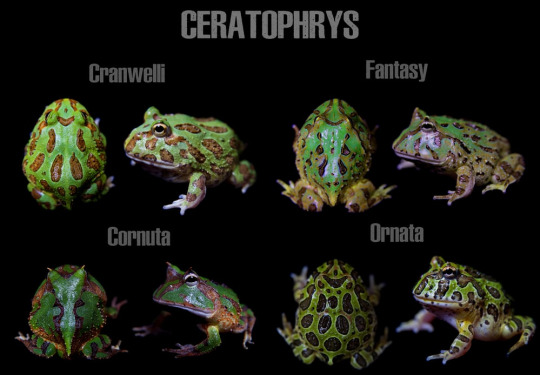
Visual differences between the three common pet pacman frogs, plus the ‘fantasy’ hybrid (source)
Unfortunately, in my experience, out of all the common pet frogs, pacman frogs seem to suffer the most from minimalistic husbandry practices. Perhaps this is due to their reputation as ‘pet rocks’- they are nocturnal sit-and-wait predators, so keepers are unlikely to see them out and about during the day. A common sight in pacman frog groups and forums is a bin or tank of no more than 10 gallons, with just some dirt, a heat mat, and a large water dish. But is that really the best we can do for them?
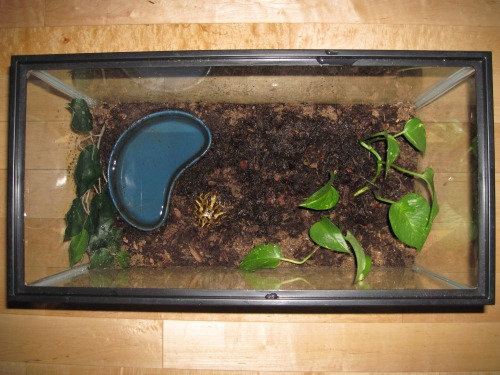
An example of a fairly typical 10 gallon setup for a pacman frog. (source)
In order to answer that question, we’ll first need to delve into their lives in the wild.
In the wild, the ranges of cranwelli, cornuta, and ornata are for the most part separate. Cranwelli is found in the dry chaco region, which includes parts of Argentina, Paraguay, Bolivia, and Brazil. Ornata is found in Argentina and Uruguay, ranging to the coast. Cornuta is found much further north and has the largest range, including Brazil, French Guiana, Suriname, Colombia, Peru, and Bolivia. There’s some possible overlap between cranwelli and ornata in Argentina.

Comparisons from Berkeley Mapper of pacman frog distribution. Orange is range as listed by the IUCN, and the blue dots are amphibiaweb records of collection sites.
Most care sheets and keepers treat these species as interchangeable as far as care requirements, but I’m a little more skeptical. Let’s go species by species through habitat information!
Ceratophrys cranwelli
The most common species of pacman frog lives in the hot, semiarid Gran Chaco region, which contains mainly dry thorn forests, savannas, and low hardwood forests. Much of the water is seasonal, but there are two permanent rivers. When it’s hot and dry, cranwelli will burrow into the soil and grow a protective layer of skin, then aestivate until the climate becomes more suitable for them again. Soil is primarily sand and clay-based. Average temperatures across the region range from 60-85 F, with average humidity ranging from 50-75%.

One of the types of habitat in the Gran Chaco in Paraguay (source)
Ceratophrys ornata
These guys live in the Pampas region of Argentina, in subtropical grasslands and seasonal wetlands. Vegetation is primarily grasses and shrubs with few trees. Humidity seems to stay around 70-80% on average. The yearly average temperature is just around 65F, with average lows around 55 and average highs around 75. Soil is described as fertile. The frogs are primarily found around the bodies of water where they breed.
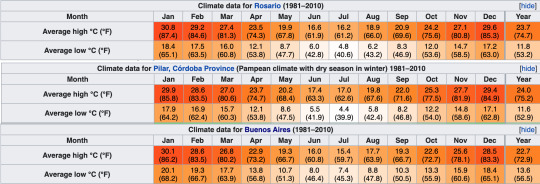
Temperature information for three locations in the Pampas region

A view of the Pampas (source)
Ceratophrys cornuta
The third of the common pet pacman frog species is found in the Amazon rainforest and the Amazon basin. The yearly average temperature is around 77 F but can reach up to the 90s during the day and down to the upper 60s/lower 70s at night. Humidity in the amazon rainforest averages 77% in the dry season and 88% in the wet season, according to the WWF. One study on the biology of cornuta cites the forests where they live as either terra firma or inundated forest and the soil asloam mixed with silt and/or clay. Individuals were usually found partially burrowed under leaf litter, with their backs near roots or logs. They mostly moved around during nights when there had been rainfall in the previous 24 hours.
In my opinion, the differences in habitat between the three species indicates that captive Ceratophrys frogs should be kept in somewhat different conditions in captivity as well. Cornuta would likely do well with plenty of leaf litter to burrow into, and seems to like the highest humidity of the three. Cranwelli seems to need the least humidity, and would likely appreciate some plant or wood cover, such as scrub vegetation. Ornata seems to need higher humidity than cranwelli, but perhaps not as high as cornuta. Their primary vegetation in the wild are grasses, so it would be recommended to mimic that in terraria. The different species may do better at different temperatures as well. I would recommend doing further research on your own on temperatures in their native habitats before deciding what temperature to keep your own pacman frog at.
In general, the small terrariums pacman frogs are typically kept in are inadequate. While a 10 gallon may be fine for growing out a young baby, many of whom are irregular eaters until adulthood, These frogs can grow anywhere from 2-6 inches, possibly more, depending on species and gender. I recommend a minimum of a 20 long (footprint of 360sq in) for male pacman frogs and a 40 breeder (footprint of 640sq in) for female pacman frogs. Of course, you can always go larger- I keep my male ornata in a 40 breeder and I have never felt the space was wasted.
All pacman frogs share some basic needs: enough substrate to burrow all the way into, a large water dish that they can soak their entire body in, cover of some sort be it hides or plants, a heat gradient, and access to UVB.
Most keepers recommend a heat mat taped to the side of the tank for providing supplemental heat. You should never use a heat mat on the bottom of the tank as pacman frogs will burrow to cool themselves down when it gets too hot. Overhead heat would be ideal, and there are many ways to go about that, each with its own pros and cons. Unless your house is particularly cold, your frog should be fine with a nighttime temperature drop down to the mid 60s/lower 70s.
UVB supplementation is controversial in the herp hobby for many species, and pacman frogs are no exception. They may be nocturnal, but that only means they are primarily active at night and does not preclude them from being exposed to sunlight. I would consider them to be a part of Ferguson Zone 1 as outlined in Ferguson et al. (2010). Animals in this zone are cryptic baskers, typically crepuscular or nocturnal. They would not need high levels of UVB, but appropriate use of a low output UV bulb is unlikely to be harmful provided the frog is able to avoid the light should they choose. I personally use a reptisun T8 5.0, but any light with a similar output used at the manufacturer recommended distance should be safe. Make sure your pacman frog is able to hide from the light if they want to by providing them with hides, plants, pieces of wood, etc.
Ultimately, we can do better by pacman frogs by simply treating them like more than pet rocks. Give them space to move around, do research into the native habitat of the species you own and do your best to mimic it in your terrarium. Feed them a variety of foods - these guys can and do eat almost anything from ants to other frogs and reptiles. Give them more than just dirt and a water dish. Make sure to only purchase captive-bred individuals. These frogs will never race around their tank or be able to be kept happily with other frogs, and you may almost never see them move during the day, but that doesn’t mean they don’t use their space in their own way.
The way I see it, you can either provide space and enrichment that they might not use, or you can deprive them of space and enrichment that they may benefit from. I think the former is preferable to the latter.
Sources, References, and Further Reading
Cranwelli
https://www.britannica.com/place/Gran-Chaco/
https://www.iucnredlist.org/species/56338/11464257
http://www.faunaparaguay.com/ceratophryscranwelli.html
Ornata
https://www.britannica.com/place/the-Pampas
https://www.iucnredlist.org/species/56340/11464790
https://en.wikipedia.org/wiki/Climatic_regions_of_Argentina#Statistics_for_selected_locations_5
Cornuta
https://galapagosinsiders.com/travel-blog/climate-weather-amazon-rainforest-temperatures/
https://www.jstor.org/stable/3892875?seq=1
https://www.iucnredlist.org/species/56337/11464093#habitat-ecology
https://wwf.panda.org/knowledge_hub/where_we_work/amazon/about_the_amazon/
General
https://bioone.org/journals/south-american-journal-of-herpetology/volume-9/issue-2/SAJH-D-14-00008.1/On-the-Diet-of-the-Frogs-of-the-Ceratophryidae/10.2994/SAJH-D-14-00008.1.short
https://www.jzar.org/jzar/article/view/150
#reptiblr#amphiblr#pacman frog#ceratophrys#ceratophrys cornuta#ceratophrys ornata#ceratophrys cranwelli#my guides
250 notes
·
View notes
Photo

Você sabia de sapo com dente? As espécies da família Ceratophryidae, que inclui o Lepidobatrachus, possuem estruturas ósseas semelhantes a dente os quais eles usam para capturar e segurar a presa. #biologia #biology #herpetologia #herpetology https://www.instagram.com/p/CaAZJhiOLxQ/?utm_medium=tumblr
0 notes
Text


Surinam Horned Frogs (Ceratophrys cornuta), family Ceratophryidae, Suriname
photographs by Marc Vaillant
1K notes
·
View notes
Photo


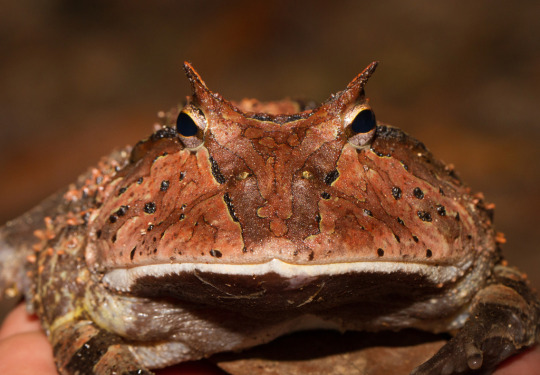
Honk for the Amazon Horned Frog
The Amazon horned frog, or the Surinam horned frog (Ceratophrys cornuta) is a medium-sized species of frog found in the tropical forests of South America. They tend to be wide and bulky, but only grow to be about 20cm in length and weigh 0.5kg. Color schemes can range from tan to green to brown, and this frog blends in very well with the leaf litter on the forest floor. The Amazon horned frog’s name comes from two horn-like protrusions over the eyes, although these are more likely meant to break up the frog’s silhouette than to be used for fighting. This species is also sometimes mistaken for a toad due to the bumps over its skin.
Like all frogs and toads, C. cornuta begins its life as an egg. After a male attracts a female by calling and the two mate, the male helps deposit the fertilized eggs onto the female’s back. The usual clutch size ranges from 300-600 eggs. The female then searches for an appropriate place-- usually an ephemeral pool-- for the eggs to develop into tadpoles, a process that takes anywhere from 3 to 25 days after being fertilized. Tadpoles are highly aggressive and will fight each other as they develop. It takes three months for tadpoles to grow into fully-formed frogs, although they do not become sexually mature for another 3 or 4 years.
In their day-to-day life, Surinam horned frog spends its time hiding in leaf litter or under fallen logs. It is an ambush predator, to which its appearance lends itself well. It’s predation actually makes it one of the most distinguished frogs, as they have one of the largest mouth-width to body length ratios. This exceptionally large mouth enables them to consume a wide variety of prey, including mice, fish, frogs, lizards, and tadpoles of their own species. Common predators consist of birds and snakes. Against each other, Amazon horned frogs are incredibly violent and will attack each other with their sharp teeth. They will also use those sharp teeth against predators or perceived threats.
Conservation status: Listed as Least Concern by the IUCN; however, they are currently threatened by heavy habitat loss and capture for the pet trade.
Photos
George Grall
Bernard Dupont (via Wikipedia)
Cullen Hanks (via iNaturalist)
#amazon horned frog#anura#Ceratophryidae#south american horned frogs#common horned frogs#frogs#amphibians#tropical forests#tropical forest amphibians#tropical rainforests#tropical rainforest amphibians#wetlands#wetland amphibians#south america#Amazon Rainforest#animal facts#biology#zoology
171 notes
·
View notes
Photo

Lepidobatrachus asper by John White
#Anura#Ceratophryidae#Lepidobatrachus#Lepidobatrachus asper#frog#frogs#animal#animals#biology#nature#wildlife#amphibian#amphibians#zoology#herpetology#herps#fauna#critter#critters
191 notes
·
View notes
Note
hey! I just saw your post about polite frogs, so if I may please ask: what's the rudest frog you got? like what's the least polite frog out there
the post in question: https://www.tumblr.com/herpsandbirds/770771646344740864
thank u :3
Impolite frogs:
If you didn't see it before, here is a post I did last week about some impolite frogs:
Herps and Birds (and More) — are there any impolite frogs?
Here's another rather impolite frog for you as well...

Ornate or Argentine Horned Frog (Ceratophrys ornata), family Ceratophryidae, from the grasslands of Argentina and Uruguay
photograph by Igor Siwanowicz
438 notes
·
View notes
Text



Amazonian Horned Frog (Ceratophrys cornuta), family Ceratophryidae, Ecuador
photograph by Cristian Torica
781 notes
·
View notes
Text

Budgett’s Frog (Lepidobatrachus laevis), family Ceratophryidae, Chaco Region, Bolivia
photograph by D. Alarcon / D. Grunbaum
1K notes
·
View notes